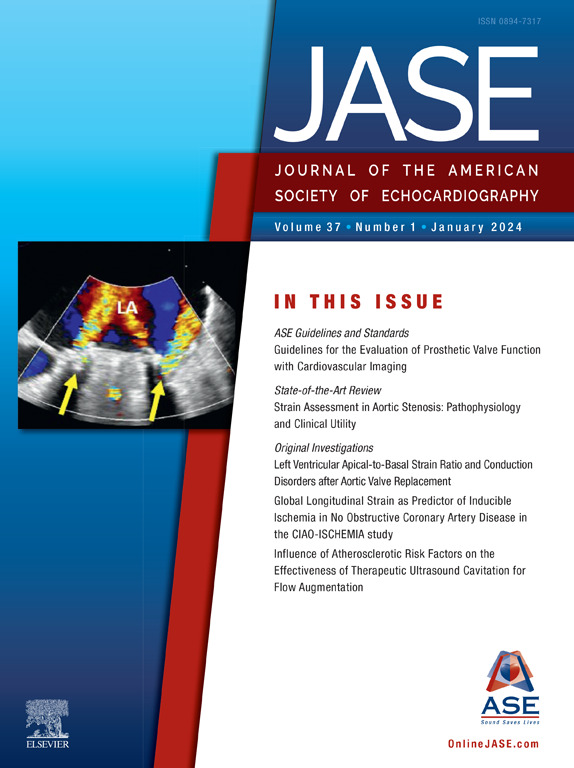次优的可靠性限制了胎儿超声心动图对大动脉右转胎儿新生儿球囊房间隔造口术的预测价值。
IF 6
2区 医学
Q1 CARDIAC & CARDIOVASCULAR SYSTEMS
Journal of the American Society of Echocardiography
Pub Date : 2025-10-01
DOI:10.1016/j.echo.2025.05.017
引用次数: 0
摘要
简介:右转大动脉(d-TGA)新生儿需要充分的混合在心房水平。如果没有这个,他们会经历严重的紫绀,需要球囊房间隔造口术(BAS)。多项研究已经确定了各种胎儿超声心动图(FE)结果作为产后BAS的危险因素。这些发现的预测价值在临床应用中仍然很差。假设:我们旨在确定FE - BAS预测因子的评分间信度(IRR)与出生后BAS以及出生后缺氧/低氧血症标志物之间的关系。我们假设较低的内部收益率可能导致有限的FE预测价值。方法:我们确定了2012年至2022年间在我们机构随访的d-TGA妊娠,排除了有较大室间隔缺陷和妊娠终止或流产的胎儿。两组三名独立读者对BAS结果进行盲测,评估了7个FE预测指标:肺静脉多普勒速度峰值> 41cm /sec、动脉导管未闭(PDA)逆流、限制性PDA、限制性卵圆孔未闭(PFO)、双向PFO血流、平鼻中隔和鼻中隔过度移动。IRR用S指标测定。收集BAS前的临床资料评价产后生理。使用多变量逻辑回归来确定FE结果与出生后BAS之间的显著关联。还使用多变量线性回归来确定FE结果与缺氧/低氧血症指标之间的显著关联。结果:纳入52例胎儿,其中25例(48%)接受了BAS。在平均胎龄34.02周(SD 2.14周)时进行体外受精。PFO流向的IRR最低,限制性PDA最高,可能是由于其稀有性。其余的FE预测因子具有中等或较大的内部收益率。5个FE特征可纳入回归分析,没有一个与BAS、出生后pH值或出生后氧饱和度的几率显著相关。PDA反向流动与产后bas前paO2降低有统计学意义。结论:我们的研究结果表明,目前FE - BAS预测因子的IRR相当可观,但并不理想。这些预测指标与d-TGA患者出生后BAS或出生后缺氧/低氧血症之间没有显著关联,除了反向PDA流和出生后低paO2。需要进一步的工作来确定更可靠的产后d-TGA生理FE预测因子。本文章由计算机程序翻译,如有差异,请以英文原文为准。
Suboptimal Interrater Reliability Limits Predictive Value of Fetal Echocardiography for Neonatal Balloon Atrial Septostomy in Fetuses With Dextro-Transposition of the Great Arteries
Introduction
Neonates with dextro-transposition of the great arteries (d-TGA) require adequate mixing at the atrial level. Without this, they experience severe cyanosis, necessitating balloon atrial septostomy (BAS). Multiple studies have identified various fetal echocardiogram (FE) findings as risk factors for postnatal BAS. The predictive value of these findings remains poor in clinical use.
Hypothesis
We aimed to determine the relationship between interrater reliability (IRR) of FE BAS predictors and postnatal BAS, as well as postnatal markers of hypoxia/hypoxemia. We hypothesized that poor IRR may contribute to limited FE predictive value.
Methods
We identified d-TGA pregnancies followed at our institution between 2012 and 2022, excluding fetuses with large ventricular septal defects and pregnancies terminated or lost to follow-up. Two groups of 3 independent readers blinded to BAS outcome assessed 7 FE predictors: peak pulmonary vein Doppler velocity >41 cm/sec, reverse flow in patent ductus arteriosus (PDA), restrictive PDA, restrictive patent foramen ovale (PFO), bidirectional PFO flow, flat septum primum, and hypermobile septum primum. Interrater reliability was determined with the S metric. Clinical information before BAS was collected to evaluate postnatal physiology. A multivariable logistic regression was used to determine significant associations between FE findings and postnatal BAS. Multivariable linear regressions were also used to determine significant associations between FE findings and indicators of hypoxia/hypoxemia.
Results
Fifty-two fetuses were included, of whom 25 (48%) underwent BAS. Fetal echocardiograms were performed at a mean gestational age of 34.02 weeks (SD = 2.14 weeks). Interrater reliability was lowest for PFO flow direction and highest for restrictive PDA, likely due to its rarity. The remainder of FE predictors had either moderate or substantial IRR. Five FE characteristics could be included in the regression analysis, and none were significantly associated with odds of BAS, postnatal pH, or postnatal oxygen saturation. Reverse PDA flow was statistically significantly associated with lower postnatal pre-BAS paO2.
Conclusions
Our results demonstrate substantial but not excellent IRR for current FE BAS predictors. There was no significant association between these predictors and postnatal BAS or postnatal hypoxia/hypoxemia in d-TGA patients, except for reverse PDA flow and lower postnatal paO2. Additional work is needed to identify more reliable FE predictors of postnatal d-TGA physiology.
求助全文
通过发布文献求助,成功后即可免费获取论文全文。
去求助
来源期刊
CiteScore
9.50
自引率
12.30%
发文量
257
审稿时长
66 days
期刊介绍:
The Journal of the American Society of Echocardiography(JASE) brings physicians and sonographers peer-reviewed original investigations and state-of-the-art review articles that cover conventional clinical applications of cardiovascular ultrasound, as well as newer techniques with emerging clinical applications. These include three-dimensional echocardiography, strain and strain rate methods for evaluating cardiac mechanics and interventional applications.

 求助内容:
求助内容: 应助结果提醒方式:
应助结果提醒方式:


